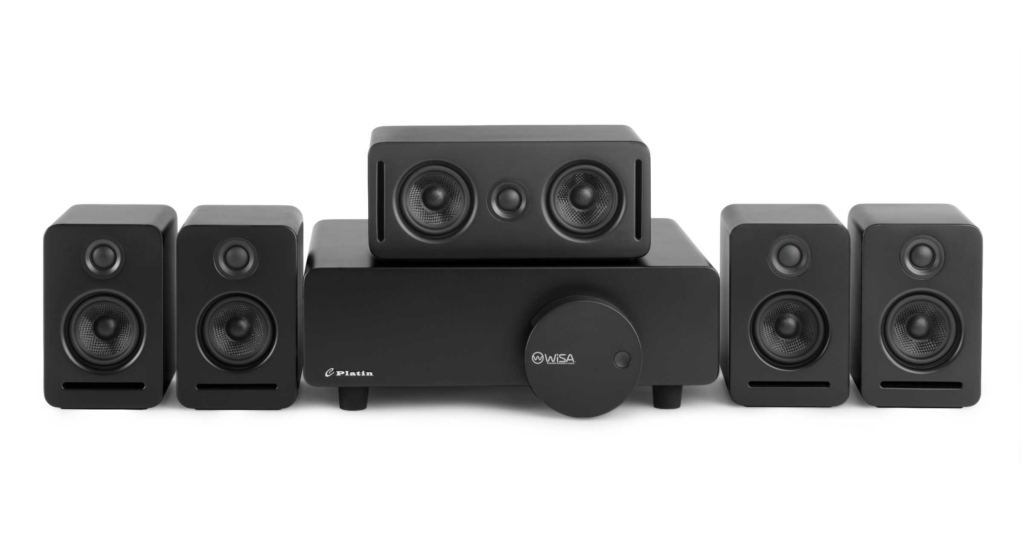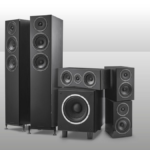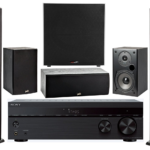Top choices include the Sonos Arc, Samsung HW-Q990C, and Vizio Elevate, catering to various budgets and performance needs. Ensure your setup includes HDMI eARC for the best audio transmission, and consider room calibration for optimal sound quality.


Table of Contents
Wireless speaker systems offer the convenience of cable-free setups and deliver high-quality audio, making them perfect for home theaters. When choosing a system, prioritize features like Dolby Atmos support for 3D surround sound, wireless subwoofers, surround speakers for immersive audio, and smart assistant integration for added convenience.
Imagine transforming your living room into a cinematic paradise without the hassle of tangled wires or complicated installations. Wireless speaker systems are revolutionizing home theaters, offering seamless connectivity, superior sound quality, and an uncluttered aesthetic.
This guide is designed to help you navigate the world of wireless speaker systems, whether upgrading your current setup or building a home theater from scratch. From understanding key features to exploring top brands, we’ll cover everything you need to know to make an informed decision.
With wireless speaker systems becoming a must-have for modern home theaters, let’s explore the features and options that will elevate your entertainment experience.
Why Choose Wireless Speaker Systems for Home Theaters?
In today’s world of home entertainment, wireless speaker systems have emerged as a game-changer, redefining how we experience sound in home theaters. Here’s why they stand out:
Convenience: Eliminate Messy Cables and Enjoy Easy Setup
One of the most appealing aspects of wireless speaker systems is the freedom they provide. Traditional home theater setups require running wires across rooms, which can be both unsightly and a tripping hazard. Wireless systems eliminate this issue, allowing you to enjoy a clean and organized living space.
Additionally, wireless speakers are incredibly user-friendly. Many models come with intuitive setup processes, often involving a simple pairing via Bluetooth or connecting to your Wi-Fi network. You can have your home theater up and running in minutes without professional installation.
No more drilling holes in walls or hiding cables under carpets—wireless systems make the setup process hassle-free while maintaining a polished aesthetic.
Flexibility: Place Speakers Anywhere in the Room for Optimal Sound
Wireless technology allows you to position speakers wherever they deliver the best sound without being restricted by cable lengths. This flexibility is essential for creating an immersive surround sound experience.
For instance, you can place satellite speakers at the back of the room for a true cinema-like feel or move them closer for intimate settings like gaming or music playback. Some advanced wireless speaker systems even come with automatic room calibration features, which adjust sound output based on the speaker’s location and the room’s acoustics.
This flexibility ensures your audio experience is high-quality and tailored to your specific space and preferences.
Technology: Advancements in Wireless Sound Quality (Bluetooth, Wi-Fi)
Wireless speaker systems have come a long way in terms of technology. Modern systems leverage Bluetooth and Wi-Fi connectivity to deliver exceptional sound quality with minimal latency. Here’s a closer look:
- Bluetooth: Bluetooth technology has evolved to support high-definition audio formats like aptX and AAC, ensuring rich and clear sound. It’s ideal for quick connections to smartphones, tablets, or laptops, making it a convenient option for casual listeners.
- Wi-Fi: Wi-Fi-enabled wireless speakers offer superior sound quality and a more stable connection than Bluetooth. These systems are perfect for streaming high-resolution audio formats, such as FLAC or ALAC, and can support multi-room setups.
In addition to connectivity options, many wireless speaker systems now feature advanced codecs, smart assistant integration (like Alexa or Google Assistant), and even proprietary technologies like Sonos’ Trueplay tuning, which adapts sound to the environment.
These advancements ensure that wireless systems provide an audio experience that rivals and sometimes surpasses their wired counterparts.
By choosing a wireless speaker system, you’re investing in convenience, flexibility, and cutting-edge technology that enhances your home theater experience while keeping your space clutter-free.
Key Features to Look for in Wireless Speaker Systems

Choosing the right wireless speaker system for your home theater involves understanding the features that make a difference. Below are the key aspects to prioritize when making your selection:
Sound Quality: Importance of Clear Audio for Movies and Music
Sound quality is arguably the most important factor when selecting a wireless speaker system. Whether you’re watching action-packed blockbusters, streaming music, or enjoying a quiet dialogue-heavy film, the clarity and depth of sound make all the difference.
Key aspects to consider:
- Frequency Response: A wide frequency range ensures you hear every detail, from deep bass to crisp highs.
- Surround Sound Support: Look for systems that support Dolby Atmos or DTS:X for a three-dimensional audio experience.
- Drivers and Subwoofers: High-quality drivers produce accurate sound, while subwoofers add powerful bass to immerse you in the action.
Investing in a system with advanced sound technologies ensures your home theater experience rivals a cinema’s acoustics.
Connectivity: Bluetooth, Wi-Fi, or Smart Assistants (Alexa, Google)
Modern wireless speaker systems offer a variety of connectivity options, each with its advantages:
- Bluetooth: Perfect for quick and simple connections to smartphones, tablets, or laptops. Ideal for casual music streaming or temporary setups.
- Wi-Fi is preferred for high-quality, uninterrupted audio streams. It also allows multi-room setups and is compatible with apps like Spotify Connect or Apple AirPlay.
- Smart Assistant Integration: Many wireless speakers have built-in voice assistants like Alexa, Google Assistant, or Siri. This feature lets you control playback, adjust volume, and even manage your smart home devices using voice commands.
Choosing a system with multiple connectivity options ensures versatility and future-proofing your setup.
Compatibility: Ensuring Compatibility with Existing Devices and TVs
Compatibility is crucial to a seamless home theater experience. Not all wireless speaker systems are universally compatible, so it’s essential to check:
- TV Connections: Ensure the system supports your TV’s output options, such as HDMI ARC, optical audio, or auxiliary connections.
- Streaming Services: Some systems integrate with specific platforms, such as Netflix, Spotify, or Amazon Music, making them ideal for your entertainment preferences.
- Ecosystem Compatibility: If you already use smart home devices, look for speakers that integrate with those systems for smooth operation.
Choosing a compatible speaker system avoids frustrations and ensures everything works in harmony.
Range and Latency: Coverage Area and Synchronization of Audio with Visuals
Wireless speaker systems operate within specific ranges and may experience latency depending on their technology.
- Range: Ensure the system has a strong transmission range for larger rooms or outdoor setups. Wi-Fi-based systems generally provide a broader range compared to Bluetooth.
- Latency: Low latency is vital for maintaining synchronization between audio and visuals, especially during fast-paced scenes or gaming. Look for systems with technologies like aptX Low Latency or Wi-Fi audio sync.
Ensuring your system offers wide coverage and minimal lag guarantees a flawless listening and viewing experience.
Focusing on these key features can help you select a wireless speaker system that delivers exceptional performance, complements your home theater setup, and meets your entertainment needs.
Top Brands and Models to Consider

The wireless speaker market is filled with exceptional brands that cater to various preferences, budgets, and audio needs. Here’s an overview of the top 10 brands and their standout models.
Top Brands Overview
1. Sonos
- Known for its superior sound quality and seamless multi-room integration.
- Popular for its app-controlled systems and compatibility with major streaming services.
2. Bose
- Renowned for its balanced sound, stylish designs, and innovative technologies.
- It often features noise cancellation and smart assistant integration.
3. Sony
- Combines cutting-edge technology with sleek aesthetics.
- Offers a range of wireless speakers, including models with 360 Reality Audio.
4. JBL
- Famous for rugged, portable speakers with powerful bass.
- Ideal for casual users and outdoor entertainment.
5. Harman Kardon
- Focuses on premium design and high-fidelity sound.
- Known for models that combine aesthetics and functionality.
6. Yamaha
- Specializes in soundbars and audio equipment for home theaters.
- Delivers clear, immersive sound for movies and music.
7. Klipsch
- Known for dynamic and precise sound performance.
- Offers powerful wireless subwoofers and stylish designs.
8. Marshall
- Iconic for its vintage-inspired designs and robust sound.
- Perfect for users who value both aesthetics and performance.
9. LG
- Offers wireless speakers with advanced sound technologies like Meridian Audio.
- Compatible with smart TVs for a fully integrated experience.
10. Denon
- Provides high-resolution sound and versatile connectivity options.
- Perfect for audiophiles seeking uncompromised quality.
Evaluation of Top Wireless Speaker Brands and Models
| Brand | Model | Price | Price Range | Key Features | Ideal For |
| Sonos | Sonos Beam Gen 2 | $449 | $$ (Mid-Range) | Dolby Atmos, compact soundbar, app control, voice assistant support | Home theater enthusiasts |
| Sonos One | $219 | $ (Entry-Level) | Alexa/Google integration, multi-room audio, sleek design | Multi-room setups | |
| Bose | Bose Smart Soundbar 600 | $499 | $$ (Mid-Range) | Dolby Atmos, Wi-Fi, Bluetooth, compact design | Movie and music lovers |
| Bose Portable Smart Speaker | $399 | $$ (Mid-Range) | 360° sound, portable, smart assistant integration | Versatile users | |
| Sony | Sony HT-A7000 | $1,299 | $$$ (Premium) | Dolby Atmos, 360 Reality Audio, HDMI eARC | High-end home theaters |
| Sony SRS-XB43 | $199 | $ (Entry-Level) | Extra Bass, Bluetooth, water-resistant | Outdoor and casual use | |
| JBL | JBL Bar 5.1 | $599 | $$ (Mid-Range) | Detachable wireless speakers, deep bass, Dolby Digital | Dynamic setups |
| JBL Charge 5 | $179 | $ (Entry-Level) | Waterproof, portable, powerful bass | On-the-go users | |
| Harman Kardon | Citation Tower | $2,499 | $$$ (Premium) | High-fidelity sound, sleek design, Wi-Fi/Bluetooth | Audiophiles |
| Aura Studio 3 | $299 | $$ (Mid-Range) | Stunning design, rich bass, Bluetooth | Stylish users | |
| Yamaha | Yamaha YAS-209 | $349 | $$ (Mid-Range) | Alexa integration, DTS Virtual:X, clear dialogue | Home theater beginners |
| Klipsch | Klipsch Cinema 600 | $599 | $$ (Mid-Range) | Powerful subwoofer, surround sound, HDMI ARC | Movie lovers |
| Marshall | Marshall Stanmore II | $379 | $$ (Mid-Range) | Classic design, Bluetooth, rich sound | Music enthusiasts |
| LG | LG SP9YA | $799 | $$ (Mid-Range) | Dolby Atmos, Meridian Audio, HDMI eARC | Smart TV owners |
| Denon | Denon Home 350 | $699 | $$$ (Premium) | Hi-Res audio, Wi-Fi, HEOS multi-room system | High-fidelity sound seekers |
Setting Up Your Wireless Speaker System
Proper setup is crucial to maximizing the performance of your wireless speaker system. Here’s a guide to ensure optimal sound quality, seamless integration, and a trouble-free experience.
Placement Tips: Achieving Optimal Surround Sound
The placement of your speakers can make or break your home theater experience. Follow these tips to achieve immersive surround sound:
1. Positioning the Speakers:
- Front Speakers: Place them at ear level and angle them slightly toward your seating area.
- Center Speaker: Position it directly above or below the TV for clear dialogue.
- Rear (Surround) Speakers: Place them slightly above ear level and behind the seating area to create a 3D sound effect.
- Subwoofer: Position near a wall or in a corner for deeper bass, but avoid placing it directly against the wall to prevent distortion.
2. Room Acoustics:
- Avoid placing speakers near reflective surfaces like glass or metal.
- Use rugs, curtains, or furniture to minimize sound reflections and enhance acoustics.
3. Speaker Calibration:
- Use the system’s calibration tool (if available) to fine-tune sound levels based on room dimensions and speaker placement.
Integration with Existing Devices: Connecting to Smart TVs or Streaming Platforms
Wireless speaker systems are designed for seamless integration, but proper setup is essential for compatibility and ease of use:
1. Connecting to Smart TVs:
- Bluetooth: Pair the speaker system with your TV by activating Bluetooth on both devices and selecting the speaker from the device list.
- Wi-Fi: Use the companion app to connect the system to your home network and select the TV as the output source.
- HDMI ARC or Optical Cable: For systems with a wired option, connect the speaker to the TV via HDMI ARC or optical cable for low latency and high-quality audio.
2. Integration with Streaming Platforms:
- Ensure the speaker system supports the platform you use (e.g., Spotify Connect, Apple AirPlay, or Google Chromecast).
- Link your streaming accounts via the speaker’s companion app to play music or podcasts directly.
- For platforms like Netflix or Hulu, ensure the system is set as the primary audio output on your TV.
3. Smart Assistant Integration:
- Enable voice control by linking your speaker to Alexa, Google Assistant, or Siri. This allows you to control playback, adjust volume, or activate streaming services hands-free.
Troubleshooting Common Issues
Despite advancements in wireless technology, occasional hiccups may occur. Here are solutions to common issues:
1. Connectivity Problems:
- Ensure all devices are on the same Wi-Fi network.
- Restart your router and reconnect the speaker system.
- Update the firmware for both your speakers and connected devices to fix compatibility issues.
2. Interference:
- Keep speakers away from devices that emit radio frequencies, like microwaves or baby monitors.
- If available, use a 5 GHz Wi-Fi band, as it is less prone to interference than the 2.4 GHz band.
3. Latency or Audio Sync Issues:
- Enable the low-latency mode in the system’s settings (if available).
- Use HDMI ARC or optical connections instead of Bluetooth for video playback to ensure perfect synchronization.
4. Software Updates: You should regularly check for software updates using the speaker’s app. Updates often fix bugs, improve connectivity, and add new features.
By following these setup tips, integrating with your devices, and proactively addressing potential issues, your wireless speaker system can provide a flawless audio experience.
Pros and Cons of Wireless Speaker Systems
Wireless speaker systems offer many benefits but also have potential drawbacks. Below is a breakdown of the advantages and disadvantages for each of the top 10 brands, helping you weigh your options effectively.
1. Sonos
Advantages:
- Superior multi-room audio integration.
- Sleek, minimalist design suitable for modern interiors.
- Supports multiple streaming platforms and voice assistants.
Disadvantages:
- Relatively expensive compared to competitors.
- It requires a strong Wi-Fi connection but lacks Bluetooth on some models.
2. Bose
Advantages:
- Renowned for balanced sound and premium build quality.
- Offers portable models with long battery life.
- Easy-to-use companion app for customization.
Disadvantages:
- Limited multi-room functionality compared to Sonos.
- Pricier than many mid-range alternatives.
3. Sony
Advantages:
- Advanced audio technologies like 360 Reality Audio and Dolby Atmos.
- Stylish designs with robust build quality.
- Wide product range catering to all budgets.
Disadvantages:
- Some models have noticeable latency with Bluetooth.
- It may require additional apps or devices for full functionality.
4. JBL
Advantages:
- Rugged, durable speakers with a focus on portability.
- Strong bass performance, ideal for casual users.
- Affordable options for various budgets.
Disadvantages:
- Audio quality may lack refinement for audiophiles.
- Limited features on entry-level models (e.g., no smart assistant support).
5. Harman Kardon
Advantages:
- Premium aesthetics and high-fidelity sound.
- Offers versatile connectivity options (Bluetooth, Wi-Fi).
- Ideal for users seeking both style and substance.
Disadvantages:
- The higher price point for flagship models.
- Limited portability due to design focus on stationary use.
6. Yamaha
Advantages:
- Excellent for home theaters with soundbars and surround sound systems.
- Clear audio for dialogue-focused content.
- Compatible with a variety of input options, including HDMI ARC.
Disadvantages:
- Limited portability; most models are stationary.
- Lacks modern smart features on some models.
7. Klipsch
Advantages:
- Outstanding sound clarity and dynamic range.
- Powerful subwoofers deliver immersive bass.
- Attractive, vintage-inspired designs.
Disadvantages:
- Bulky designs may not suit smaller spaces.
- Pricier options for entry into the brand.
8. Marshall
Advantages:
- Iconic vintage design with durable materials.
- Loud, robust sound suited for music enthusiasts.
- Bluetooth compatibility for easy connection.
Disadvantages:
- Limited multi-room functionality.
- Lacks some modern features like voice assistant integration.
9. LG
Advantages:
- Excellent integration with LG TVs and smart home ecosystems.
- Advanced sound processing technologies (e.g., Meridian Audio).
- Competitive pricing for mid-range models.
Disadvantages:
- Audio quality may not match premium brands like Sonos or Bose.
- Limited standalone speaker options; focuses more on soundbars.
10. Denon
Advantages:
- High-resolution sound for audiophiles.
- HEOS multi-room system offers excellent versatility.
- Durable and well-constructed devices.
Disadvantages:
- Complex setup for some users.
- Premium pricing may deter budget-conscious buyers.
FAQ’s
What are wireless speaker systems for home theaters?
Wireless speaker systems for home theaters are audio setups that use wireless technology (such as Wi-Fi or Bluetooth) to connect speakers, eliminating the need for physical speaker cables. They provide flexibility in placement and are ideal for creating a surround sound experience without extensive wiring.
Are wireless speaker systems truly wireless?
While the audio signal is transmitted wirelessly, most wireless speakers still require a power source, typically a power cable or rechargeable battery. Due to their power demands, fully wireless options running on batteries are less common for home theater setups.
What features should I prioritize in a wireless speaker system?
Key features to consider include:
- Sound Quality: Look for Dolby Atmos, DTS:X, or Hi-Res Audio support.
- Connectivity: Wi-Fi, Bluetooth, HDMI eARC, and optical ports.
- Ease of Setup: Plug-and-play or app-guided configurations.
- Compatibility: Ensure the system works with your TV, streaming devices, or gaming consoles.
- Smart Features: Voice assistant integration (e.g., Alexa, Google Assistant) and multi-room audio capabilities.
How do wireless speaker systems handle surround sound?
Many systems use wireless surround speakers and a subwoofer to create a true surround sound experience. Technologies like Dolby Atmos can also simulate overhead sound, enhancing immersion.
Are wireless speaker systems compatible with all TVs?
Most wireless systems are compatible with TVs that support HDMI ARC/eARC, optical, or Bluetooth connections. However, it is important to check the system’s specifications and your TV’s outputs before purchasing.
How do I minimize audio lag in wireless systems?
To minimize audio lag:
- Choose systems with low-latency technology.
- Use Wi-Fi-based systems instead of Bluetooth for faster and more stable connections.
- Ensure firmware is updated and avoid interference from other wireless devices.
Can I expand my wireless home theater system over time?
Yes, many systems support expandable configurations. For example, you can start with a soundbar and add wireless rear speakers or a subwoofer later for a full surround sound experience. Check for compatibility within the same brand or ecosystem.
Conclusion
Selecting the right wireless speaker system is essential to unlocking the full potential of your home theater. Whether watching the latest blockbuster, streaming a concert, or enjoying a casual movie night, the right system ensures immersive, high-quality sound that brings your entertainment to life.
Investing in a system that fits your needs—sound quality, connectivity, or budget—can significantly elevate your audio experience. With so many options available, from top-tier brands like Sonos and Bose to versatile and affordable options like JBL and LG, there’s a perfect fit for every home theater enthusiast.
Why settle for average sound when you can enjoy cinema-quality audio at home?
Upgrade your home theater experience with the best wireless speakers today!
Share Your Opinion
Have you recently upgraded your home theater with a wireless speaker system? Which brands and features stood out to you? Share your thoughts and recommendations in the comments below—we’d love to hear from you!



